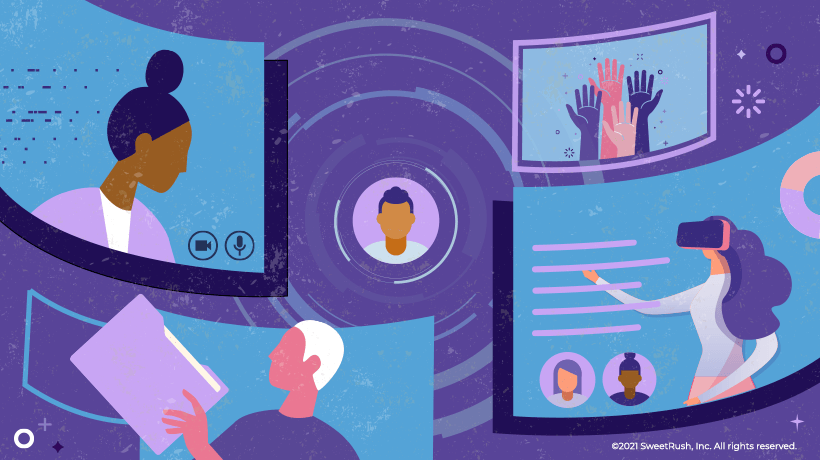Reflect On Your New Reality!
This time last year, the buzzword for many of us in L&D was digital transformation. Our inboxes were full of tips for rapidly converting Instructor-Led Training (ILT) programs to digital experiences. We responded to an immediate and pressing need to make existing content available to audiences in a different format.
Today, as more companies announce a shift to hybrid working models, the demand for accessible on-demand content remains a priority. According to the LinkedIn 2021 Workplace Learning Report, “...73% of L&D professionals expect to spend less on ILT, and 79% expect to spend more on online learning” [1].
While the digital transformation of learning content was a great solution for a remote workforce’s needs during a time of crisis, simply converting content from one format to another is no longer the right—and only—thing to do. This is especially true for leadership development content. According to a 2019 poll of HR executives run by our client-partner SHRM, the four key areas HR executives say matter most to enterprise success and workplace culture are:
- Effective communication
- Performance management
- Team leadership
- Situational judgment [2]
Let’s imagine for a moment that in 2019 you created a leadership development curriculum based on these four areas. You’d have designed content and experiences that reflected your company’s culture and practices at that time—that is, office-based, face-to-face leadership.
While these four areas of success are still relevant today, how your leaders go about communication, performance management, team leadership, and situational judgment will be vastly different in a hybrid workplace. A simple one-to-one conversion of your 2019 content won’t be enough for today’s hybrid leaders.
Here are three key areas for L&D to focus on as you reimagine your existing leadership development training and align it with your company’s current hybrid reality.
1. Reimagine Leadership Culture
The pandemic has forced businesses to reassess their culture and evaluate and refine ways of working.
At SweetRush, we entered 2020 in a comparatively strong position. As a fully virtual company since 2009, remote working and remote leadership were already our “normal.” But as the world around us changed, so did the needs of our clients, and their clients, not to mention our own team members—our culture and practices had to follow suit.
We dialed up caring. We adjusted timelines. We created tools and resources to help clients adapt and adjust to remote and hybrid worklife. We did the same for SweetRush parents, who were struggling to homeschool their kids. Flexible hours were made even more flexible. People were given much-needed time off. Teammates stepped in and stepped up.
In our case, the pandemic didn’t radically alter our core values, but it did amplify our focus on human-centered business and continues to influence the way we hire, onboard, and lead others today [3].

For other companies—including many of our clients—the shift was more extreme and continues to have a significant impact on day-to-day operations and leadership practices. If this resonates with you, take time to reflect on your new reality and how it impacts your leadership development program. Here are some thought starters.
- How have your company’s culture and values evolved?
Work with senior leadership to identify what’s changed. What, if any, changes are there to the company’s values, vision, strategy, or purpose? - What does the new company culture look like?
Identify how the new culture manifests itself in the day-to-day. What do you notice? Is there a greater sense of connectedness? How have attitudes and expectations toward teams and individuals changed? What does accountability look like now? What about flexibility? How does it differ from before? - How might this impact leadership development?
Synthesize this data and ask, "So what?" What does this mean and how might it affect your leadership development program:- How will you embed changes to the culture, values, vision, purpose, and strategy?
- What mental model shifts might leaders need to make? How will you help them do this?
- What tools and resources will you need to revise or create?
- Will you need to develop separate content and experiences for new and existing leaders?
2. Reimagine Leadership Behaviors And Competency
As workplace culture evolves, so too have the role and expectations of leaders. In a webinar on leading remote teams through the pandemic, we were asked by an audience member to share the qualities of good leaders in times of crisis. Our experts were in agreement; empathy, compassion, and a servant leadership mindset topped the list [4].
But transformation doesn’t happen overnight. You need to communicate to leaders what their new role entails and equip them with the necessary skills to succeed. We recommend using your existing leadership competency model as a benchmarking tool for identifying gaps. Here’s what to do.

First, identify a representative sample of your target audience from the leadership team. We recommend partnering with leaders from different business units and with different levels of experience to help with this work (see more on this in the next section of this article).
Next, ask your target audience to review the existing leadership competencies and skills to identify which ones are still relevant, which ones need to be adapted, and what’s missing. Help your SMEs through this process by asking them to reflect on the following as they complete their review:
- What does leadership look like in a hybrid workplace?
- How have the leadership roles and responsibilities changed—what are leaders doing now that they weren't doing before?
- What skills and competencies do today's leaders need?
Finally, validate the data with other leaders and ask them to rank their current level of competence along with their confidence in applying the behaviors. Use the data to inform any necessary changes to your leadership development program.
Don’t have a set of competencies in place for leadership? The next best thing you can do is a needs analysis.
Begin your needs analysis by partnering with senior leadership and stakeholders to identify the new business needs and desired performance outcomes. Then meet with members of your target audience—current leaders—to identify the performance gaps and learning objectives. Use this data to identify any content gaps in your current leadership development program and then work with SMEs to develop training and experiences that will close those gaps.
3. Reimagine Leadership Expertise
Our final piece of advice is to rethink what you know about leadership “experts.” Your go-to leadership SMEs from pre-pandemic times may not be the same people you need to speak to today.
We’re not suggesting you dismiss your most seasoned and senior team members, but we are suggesting that you don’t dismiss your newest leaders either. For some of them, remote and hybrid working and leadership is all they know!

New leaders will add contrast and offer fresh and alternative perspectives on what’s working and what’s needed from leaders to be successful. Lean into their unique experience and help them help you define today’s leadership behaviors. Don’t forget to get input from the leaders’ direct reports. Ask for their feedback on what’s working and what’s lacking for them since transitioning to a hybrid model.
References:
[1] 2021 Workplace Learning Report
[2] National Career Development Month
[4] Serving Your People, Serving The World: Building A Life-Centered Business At SweetRush
Additional Resources:
Need help refreshing your leadership development content? We’ve developed a number of resources to help leaders and L&D professionals navigate the demands of today’s workplace.










